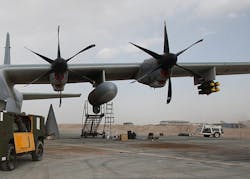Air Force awards $25 million contract to Raytheon to build Griffin lightweight missiles
Officials of the Air Force Life Cycle Management Center at Eglin Air Force Base, Fla., announced a $25 million contract to the Raytheon Missile Systems segment in Tucson, Ariz., on Friday for AGM-176 Griffin A Block III missiles for deployment from the rear of aircraft.
Griffin is a small, lightweight GPS-aided-inertial- or laser-guided missile designed originally for special operations aircraft. It has a relatively small 13-pound warhead to keep collateral damage to a minimum. The missile is nearly four feet long, 5.5 inches in diameter, and weighs 45 pounds.
The multi-platform, multi-service weapon homes in on its target by following signals from a laser-designation system or by satellite navigation signals from orbiting GPS satellites and inertial gyros.
Related: Raytheon wins job to build lightweight missiles for attack UAVs and special-ops aircraft
Aircraft that can fire the Griffin A aft-deployed missile include the KC-130J Harvest HAWK, MC-130W Dragon Spear, and AC-130J Ghostrider special operations aircraft.
Griffin has a blast-fragmentation warhead that users can set for height of burst, point detonation, or fuze delay. Its targets include fast-moving small attack boats, light vehicles, or unreinforced command posts and radar stations.
Griffin comes in four variants: Griffin A is the aft-eject missile; Griffin B is a forward-firing missile; Griffin C has dual-mode guidance and in-flight retargeting; and Griffin C-ER is an extended-range missile. Griffin A production started in 2008.
Depending on the version of the Griffin missile, the smart munition can fire from unmanned aerial vehicles (UAVs), small ships, and special-operations utility aircraft.
In addition to the KC-130J Harvest HAWK, MC-130W Dragon Spear, and AC-130J Ghostrider special operations planes, aircraft and ships that can fire the missile include the MQ-1 Predator and MQ-9 Reaper fixed-wing unmanned aircraft; the MQ-8B Fire Scout unmanned helicopter; the A-29 Super Tucano ground-attack turboprop aircraft; the Cyclone-class patrol ship; and the V-22 Osprey tiltrotor.
Aircraft can carry three Griffin missiles in the space required by the AGM-114 Hellfire missile, which is the typical armament of UAVs like the Predator and Reaper.
On this contract Raytheon will do the work in Tucson, Ariz., and should be finished by December 2017. For more information contact Raytheon Missile Systems online at www.raytheon.com, or the Air Force Life Cycle Management Center at www.wpafb.af.mil/aflcmc.
Learn more: search the Aerospace & Defense Buyer's Guide for companies, new products, press releases, and videos
